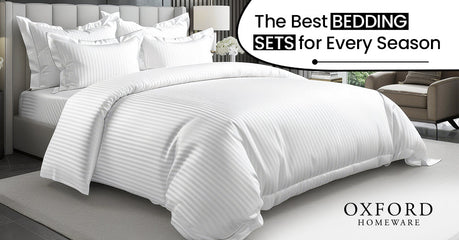How Do You Best Use A Duvet Cover
Although changing a duvet cover can be challenging, doing so is necessary to prolong the life of your duvet. And changing the cover is a simple way to update your bedding. A duvet's warmth will increase with a heavier fabric, and a luxurious cover will immediately upgrade its elegance.
Picking up the right bedding is the first step in transforming your bedroom into a relaxing retreat. Your choice of pillow and pillowcases, bedsheets or duvet, and the use of mattress protectors or bedspreads, can all affect how well you sleep.

What Does Duvet Cover Mean
Duvet coverings are comparable to a pillowcase if duvet inserts are to pillows. You can use them to protect your duvet insert against germs from your body. Or, if you like to eat in bed, any midnight snacks you might spill. The cover is closed with a tie, and a duvet insert slides inside.
In smaller washing machines, washing duvets and comforters can be difficult. Therefore most people find it much simpler to remove the duvet cover and wash it alongside their other sheets and pillowcases. This type of mattress has other benefits as well. It is also incredibly adaptable.
Many people enjoy switching out their duvet coverings seasonally. Lightweight textiles like linen work well in the summer, whereas thick fabrics work best in the colder months.
A quilt or blanket can really tie the colour scheme of a room together and keep you warm, and some people also choose to style their duvet coverings in this way. It's simpler and less expensive to replace a duvet cover than a full duvet or comforter, whether you need a new look for the season or just want some different scenery.
Factors to Consider Before Adding A Duvet Cover To Your Space
Duvet Cover Material
While choosing the duvet fill is important, don't overlook the duvet cover as well. Using breathable, light materials like cotton is usually the most common option. But there are a lot of other options as well. Fabrics made from natural materials typically breathe better than synthetic fabric. However, they are more expensive. For duvet covers, these are a few fabric choices:
Cotton
Cotton is the most common material for duvet covers due to its lightweight, breathability, and softness. It is both breathable and insulating, making it an ideal material for every season. Cotton might be an excellent alternative if you value a simple fabric to clean.
Multiple varieties of cotton are commercially available. Duvet covers buyers who care about social and environmental responsibility and seek to advance to organic cotton. Supima, Pima, Egyptian cotton, and other high-quality cotton alternatives tend to last longer than regular cotton.
Flannel
On a chilly night, flannel can make sleepers feel toasty. Comfortable and durable, the cloth has a pleasant feel. Machine washable and easy to clean, flannel duvet covers are widespread. Flannel has the drawback of being reasonably warm on a warm night, so you might need to get several duvet covers to change them according to the seasons.
Silk
Covers for duvets are from silk that is breathable and delicate. Silk regulates body temperature more effectively than most synthetic textiles because it is a natural product. All year round, you can wear the smooth, cool fabric. Even though silk has many benefits, it is typically more expensive. Although silk doesn't require as frequent washings as other fabrics, it's still important to do it according to the label's guidelines. If the silk duvet covers are washable, it is advisable to do so in a mesh laundry bag and then dry it by hanging it.
Which Duvet Cover Size Is Right for Your Bed?
As part of its design, duvets need that they are on beds at least 25 cm from the head of the bed. A UK double bed mattress, for instance, measures 190 cm long. Therefore, if the duvet for a double bed is 200 cm long, there will be a 35 cm additional duvet at the foot of the bed. This is sufficient for someone to sleep soundly without worrying about their feet being exposed and cold.
Some people like to use oversized duvets on their beds. People frequently choose a Super King-sized Duvet for a King-sized bed or a King-sized Duvet for a Double bed.
Check if the duvet's dimensions are appropriate for your mattress. Using a double-sized duvet for a double-sized bed, for instance, or a single-sized duvet for a single-sized bed. It gives your bed a tidy, appealing appearance.
However, if you feel you must purchase a larger duvet for your bed, we advise not going any more extensive than the size up. Get a King-sized duvet cover, at maximum, for a Double bed, for instance. Your bed's duvet cover size should correspond to one of these standard dimensions.
Duvet Tog Rating
A tog rating can be between 2.5 and 15 but typically ranges between 4.5 and 13.5. Summer duvets are lighter at the lower end of the range. In contrast, winter duvets with a 13.5 tog rating are significantly warmer and are generally for the cold season.
In the UK, most people buy togs between 10.5 and 13.5 to stay warm in the ordinarily chilly weather. Some people prefer a 4.5 tog summer duvet and either a 10.5 tog or a 13.5 tog winter duvet.
An all-seasons duvet is perfect if you desire a year-round solution. You can use two duvets together as the ideal solution for changing seasons. When you want to feel cooler in the summer, you can take off your duvet; in the winter, you can put it back on. With the all seasons duvet, you have three different duvet options in one. It is a 4.5 tog duvet that press-studs to a 10.5 tog duvet.
What Does The Structure Of A Duvet Cover Look Like?
Usually, two rectangular pieces of fabric are stitched together on all four sides to create a duvet cover. Cut the middle of one sheet to make room for the duvet inside the cover. Also, high-quality duvet covers have ties at each corner, bound to the duvet in all four corners. Because of this layout, the duvet won't bunch up inside the cover.
Additionally, duvet covers contain a closure component, such as buttons or zippers. Some can buy with various decorative accents like buttons, ribbons, or embroidery, giving them more character and texture. Additional embellishments on high-quality duvet covers include pleats, ruching, and flocking. Ruching is a related technique that gathers little ripples in the fabric, whereas pleating is a form of fold created by folding fabric over itself. Small particles are deposited on a fabric's surface to create flocking.
How Does The Look Of The Duvet Cover Influence Your Choice?
Since duvet covers are one of the room's biggest visual components, they significantly affect how it looks. Because of this, it's crucial to consider the effect a duvet cover will have while making your choice. Thankfully, the best duvet cover materials are easily accessible in a wide range of hues and patterns to complement any bedroom.
Solids are a terrific option if you already have your bedroom décor in place and want to add a splash of colour. If you want to design the bedroom around the duvet cover, intricate designs like branches, flowers, and stripes may be better.
When combined with softer components like lace curtains, embellishments like pleats can add a decorative texture that looks fantastic. Reversible duvet covers allow you to rapidly change the appearance of your bedroom without any added price.
Comforter Vs Duvet
The choice will ultimately be up to you and your particular preferences. A duvet frequently has more fluff than a comforter. It arrives in two sections instead of a comforter, which is available for use immediately and is only one piece.
An easy-to-use, ready-made product with a matching set is what you want. If you want your bedding to have layers, go with a comforter.
In contrast, a duvet requires little maintenance and is adaptable. You should use a duvet if you want your appearance to be fluffy.


